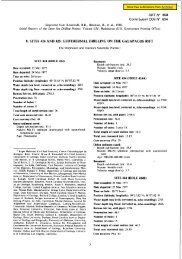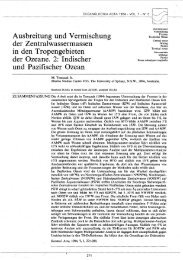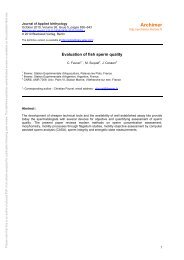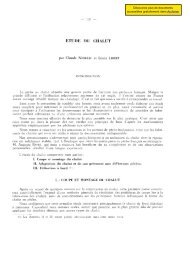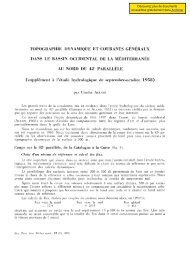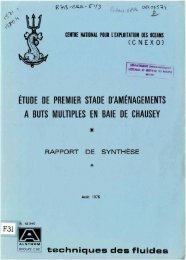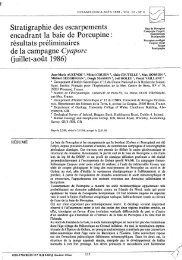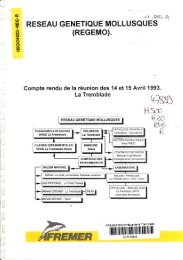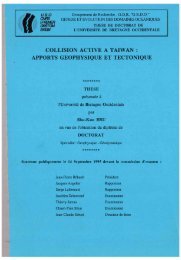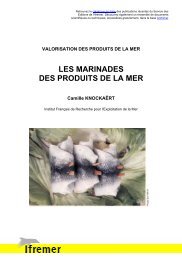Contribution à l'étude de virus de mollusques marins apparentés ...
Contribution à l'étude de virus de mollusques marins apparentés ...
Contribution à l'étude de virus de mollusques marins apparentés ...
Create successful ePaper yourself
Turn your PDF publications into a flip-book with our unique Google optimized e-Paper software.
infection. Then, a weak green fluorescence was observed, in contrast to the red native<br />
fluorescence of cells. The titer could be <strong>de</strong>termined from the eighth day, as single<br />
infected cells with strong green fluorescent cytoplasms cou Id be easily distinguished<br />
(Table 3).<br />
LabeUing of infected cells was observed from the second day when applying the<br />
15DIIC9 monoclonal antibody. However, consi<strong>de</strong>ring the low intensity of the<br />
fluorescence during the first days of infection, the titer could be calculated precisely<br />
first from the seventh day post-infection and onwards (Table 3).<br />
Discussion<br />
ln the present work a production of LDV specific monoclonal antibodies was<br />
obtained using infected BF2 cells as antigen. LDVs may be purified from fish<br />
nodules (Schnitzler, Riisen-Wolff & Darai, 1990) or, with relatively low yields, from<br />
infected cell cultures (Robin & Berthiaume, 1981). In both cases antigens would<br />
mainly consist of viral structural proteins. Infected cells represent more complex<br />
antigens, containing a mixture of cellular and viral epitopes which may be<br />
advantageous when producing monoclonal antibodies for use in early infection<br />
diagnosis, as <strong>de</strong>tection of non-structural viral proteins may then be important. This<br />
might have been the case in the present study, as three of the monoclonal antibodies<br />
produced enabled antigen <strong>de</strong>tection as soon as two or three days post-infection.<br />
The suitability of the immunogen used here was confirmed by the LDV -specific<br />
reactivity of immune sera after absorption with acetonic extracts of BF2 cells.<br />
However, due to the relative abundance of antibodies against BF2 cellular antigens, it<br />
was supposed that an important proportion of immunized mouse spleenocytes, and<br />
subsequently hybridomas, would be specific of cellular antigens. The hybridoma<br />
precloning limited the risk of obtaining mixed antibodies, sorne possibly reacting<br />
with BF2 cell antigens, masking antibodies specific for LDV antigens. Additionally<br />
the hybridoma selection was accurate due to the direct visualization of fl uorescence<br />
which enabled an i<strong>de</strong>ntification of even subtle and faint green fluorescent dots, and<br />
also to compare reactivities against LDV infected and non-infected BF2 cells. The<br />
direct immunofluorescence assay (HF A) was easy to perform due to the application<br />
of a protocol using microculture plates as <strong>de</strong>scribed by Stitz el al. (1988).<br />
Cell culture conditions were improved throughout the experiments as it was observed<br />
that LDV -infected cells had a tendancy to <strong>de</strong>tach and be lost during HF sample<br />
treatment. Wells were therefore treated with poly-D-Iysin previously to BF2<br />
inoculations. After incubation, <strong>virus</strong> suspensions were replaced by fresh medium and<br />
ad<strong>de</strong>d methyl cellulose. This procedure proved efficient as infected cells remained at<br />
the weil bottom until formal<strong>de</strong>hy<strong>de</strong> fixation and during immunofluorescent assay.<br />
il appeared that II A2 was the most suitable monoclonal antibody due to its<br />
reliability in i<strong>de</strong>ntifying infected cells at low magnification. This permitted a rapid<br />
examination of microculture wells. However, other monoclonal antibodies are also<br />
suitable, in particular l5DIIC9, which produced a pin-point cytoplasmic<br />
fluorescence being recognizable as soon as Iwo days post-infection.<br />
Titer estimation by observation of cytopathic effects on BF2 cells did not give a<br />
precise LDV titration since it was difficult to interpret these observations after the<br />
seventh day post-infection. Compared to the observation of cytophathic effects,<br />
indirect immunofluorescent assay was far more sensitive since it was possible to<br />
194



